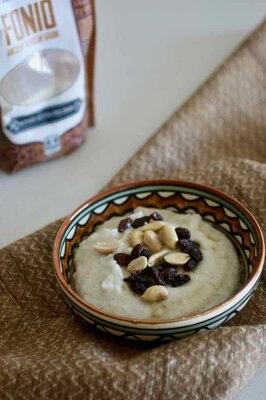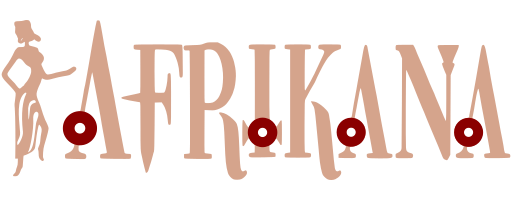Nutritious, organic and gluten-free fonio pudding, or fonio porridge (acha) is a fonio-based milk porridge.
It is traditionally served for breakfast in Nigeria and the rest of West Africa.
Fonio, acha, iburura, African millet or "hungry man's rice". Its scientific name is Digitaria Exilis. All names belong to an ancient grain of African heritage that is gaining more and more attention worldwide. In some parts of West Africa, fonio has sociocultural significance.
In some African countries, fonio was not only important as a nutrient.
- In Senegal, Burkina Faso, Mali and Togo, it was traditionally reserved for chiefs and royal families.
- It is also used in Nigeria, Ghana, Benin and Chad.
- In some parts of Togo, fonio is still used today to prevent blood clotting after childbirth and to stimulate milk production.
Despite the valuable nutrients it provides, growing this cereal is easy: it thrives in dry conditions and in poor soils, it doesn't even need fertilization.
Fonio is a very small grain with small grains measuring approximately 1 to 1.5 mm. The small fonio grain belongs to the family of another cereal, millet. It can be used both as a cereal and in the form of flour. It looks like quinoa and couscous. It has a mild taste and is slightly sweet.
This grain is so easy to grow that it has been nicknamed the "lazy farmer's crop" because it only takes 6 to 8 weeks to plant the seeds in a barely plowed field after rain, making the grains quickly available for consumption.
It is therefore a plant that perfectly adapts to dry and sandy soils, optimally withstands a dry climate without the need for water or chemicals for cultivation. This plant is characterized by the fact that it produces its own antiparasitic substances, therefore it does not require further processing, which by definition results in a naturally organic grain.
What is the origin of fonio?
Fonio, with its nutty flavor, is the oldest cereal in Africa and has been cultivated since time immemorial. Its popularity once spread as far as Egypt, where the seeds were found in the tombs of some pharaohs. Its cultivation dates back to 5000 BC and several myths are associated with this cereal. For example, according to the mythology of the Dogon of Mali, Amma, the creator of the universe, created the entire universe by exploding a single grain of fonio found in the "germ of the universe".
In 2006, the European Union decided to allocate funds for the production of phono. The European Commission has approved the introduction of fonia in Europe as a "new food" or "superfood". Fonio included it among the "50 foods of the future, excellent for the well-being of the planet and people".
The fonio seed is so small that in the very recent past, shelling fonio was a difficult task. Today, thanks to a machine specially designed for fonia peeling, it is possible to peel and crush tons of fonia at the same time.
What are the benefits of fonio?
"With fonio, a cook never needs to be ashamed", so says a West African folk saying. In West Africa, where it is cooked like semolina, it is a particularly popular dish that often appears on holiday and celebration menus. Fonio has exceptional nutritional properties. It is a cereal that does not contain gluten, has a low glycemic index, high fiber content and is very easily digestible.
Its nutritional value is similar to wheat, but with a lower percentage of protein. Methionine is an amino acid that plays a very important role and is essential for the human body, ensuring the presence of 8 essential amino acids. Fonio is particularly rich in mineral salts such as iron, calcium, manganese, zinc, phosphorus and magnesium and in vitamins especially B1 and B2. Compared to rice and wheat, fonio contains significantly higher amounts of sulfur-containing amino acids - methionine and cysteine.
As an essential amino acid, methionine must be obtained from food, the body cannot create it. It plays a role in skin elasticity, hair growth, nail health, and the growth and repair of body tissues. Cysteine is a non-essential amino acid, necessary for protein synthesis and detoxification. Fonio is considered a whole grain food with all the benefits and is alsofrom gastrointestinal disorders, fonio is very digestible naturally gluten-free.
Who is fonio suitable for?
For anyone following a gluten-free diet, it is an excellent alternative to a varied, natural and nutritious diet. For those suffering from diabetes, because compared to other refined grains, fonio creates a slow release of sugars. It contains sulfur, chromium, and amino acids that help control diabetes, and studies have shown that eating it can be a way to control blood sugar levels.
For people suffering from gastrointestinal disorders, fonio is very digestible, does not cause swelling and the high fiber content improves intestinal transit and helps against constipation. Cereals and flour are a gentle, healthy and nutritious solution for weaning babies. For those who need to strengthen hair and nails thanks to the richness of methionine. For pregnant women and especially those who need to supplement their diet with foods rich in iron. For those who are allergic or intolerant to nickel, fonio has a low nickel content.
Recipe ideas based on Fonio
Fonio beans are prepared very quickly, it only takes a few minutes. Fonio is suitable for sweet and salty preparations, mixed with stronger flours such as buckwheat, and sweeter ones such as millet, corn and rice. It can be used in salads, for example instead of quinoa and rice. In Senegal, they offer an excellent fonio salad with chicken and mango, or it is a delicious side dish for mafé - lamb stew, or beef with tomatoes and peanuts, yassa - marinated chicken, or thieboudienne - rice and fish.
In Ghana, okro stew, the national dish, is made with tomatoes, red palm oil, onions, spices and finely chopped okra, also served with fonio. Suya, is grilled and chopped beef, mutton or chicken that is popular on the streets of Ghana, Nigeria, Niger, Cameroon and Sudan and goes very well with fonio.
It can be used in warm or cold dishes together with fish or meat. After cooking, it is excellent for mixing with delicious fish balls, such as Senegalese thiou (fried fish balls), or meat, with vegetable garnishes, or even with vegetable burgers.
Fonio flour is great for all types of baked goods such as biscuits, cakes and breads.




Commets 0
Add a comment